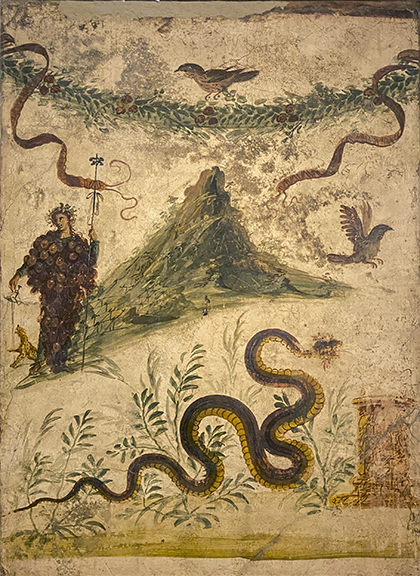

"This is Vesbius [Vesuvius], green yesterday with viny shades; here had the noble grape loaded the dripping vats; these ridges Bacchus loved more than the hills of Nysa [the mythical place where he was raised]; on this mount of late the Satyrs set afoot their dances; this was the haunt of Venus, more pleasant to her than Lacedaemon; this spot was made glorious by the fame of Hercules [Herculaneum]. All lies drowned in fire and melancholy ash; even the High Gods could have wished this had not been permitted them."
Martial, Epigrams (IV.44)
Although vineyards and trellises can be seen covering "those most famous slopes of Vesuvius and of Surrentum in Campania" (Columella, On Agriculture, III.2.10)), vines often were allowed simply to entangle themselves in trees, the poplars of Campania "embracing their brides and climbing with wanton arms in a series of knots among their branches, rise level with their tops, soaring aloft to such a height that a hired vintager expressly stipulates in his contract for the cost of a funeral and a grave!" (Pliny, Natural History, XIV.iii.10). Elms, too, often were overtopped with vines. Other grapevines were propped up with stakes or allowed to stand by themselves, those of Fundi, for example, being "grown on trellises or trained up small trees" (XIV.viii.65) and of Sorrento, only on palisades. Such was the nostalgia for the honest labor of working one's ancestral land, wedding "the fully grown layers of the vine to tall poplars" (Horace, Epodes, II).
In the Natural History, which was published in AD 77, Pliny comments on the wines of Campania, which "whether by means of careful cultivation or by accident, has lately excited consideration" (XIV.viii.69). Two years later the countryside would be devastated by the eruption of Vesuvius.
In the wall painting from Pompeii, Bacchus is garlanded and clothed in a cluster of grapes, with a panther at his feet. This detail shows the trellises to better effect.
References: Martial: Epigrams (1993) translated by D. R. Shackleton Bailey (Loeb Classical Library).